Part Requests in an Altium 365 Workspace
Parent page: Altium 365 Workspace
The number of design components available to an engineer when capturing their next design can vary from a few hundred through to hundreds of thousands. But no matter how many components are available to hand there will always be more that aren't, and that need to be created and added for reuse.
For a small design house, an engineer will simply change 'hats' and become the Librarian – creating required components that are missing from their design arsenal. However, for a larger organization that employs a dedicated library department to grow and maintain the design components – accessible to all engineers and designers in that organization – it makes sense to submit requests for new (missing) components to that department. Providing an elegant solution to this, Altium Designer, in conjunction with your Altium 365 Workspace, offer the Part Requests feature.
An engineer can simply put in a request for one or more parts to be created and get notified when that request has either been completed, and the component(s) made available, or rejected (and why). The requestor supplies as much key information to support their request as possible (manufacturer and part number(s), description(s), any relevant datasheet (PDF or URL)). Stub Component Items can even be created that the librarian can then run with (and finish off).
Nominating Your Librarians
First things first, you'll need to specify which group (or groups) should be used to fulfill the role of Librarians for your organization. In essence, you are configuring a set of users of your Workspace that can be assigned to a part request. This is performed on the Admin – Settings – Vault – Part Requests – Librarians Role page of the Workspace's browser interface.
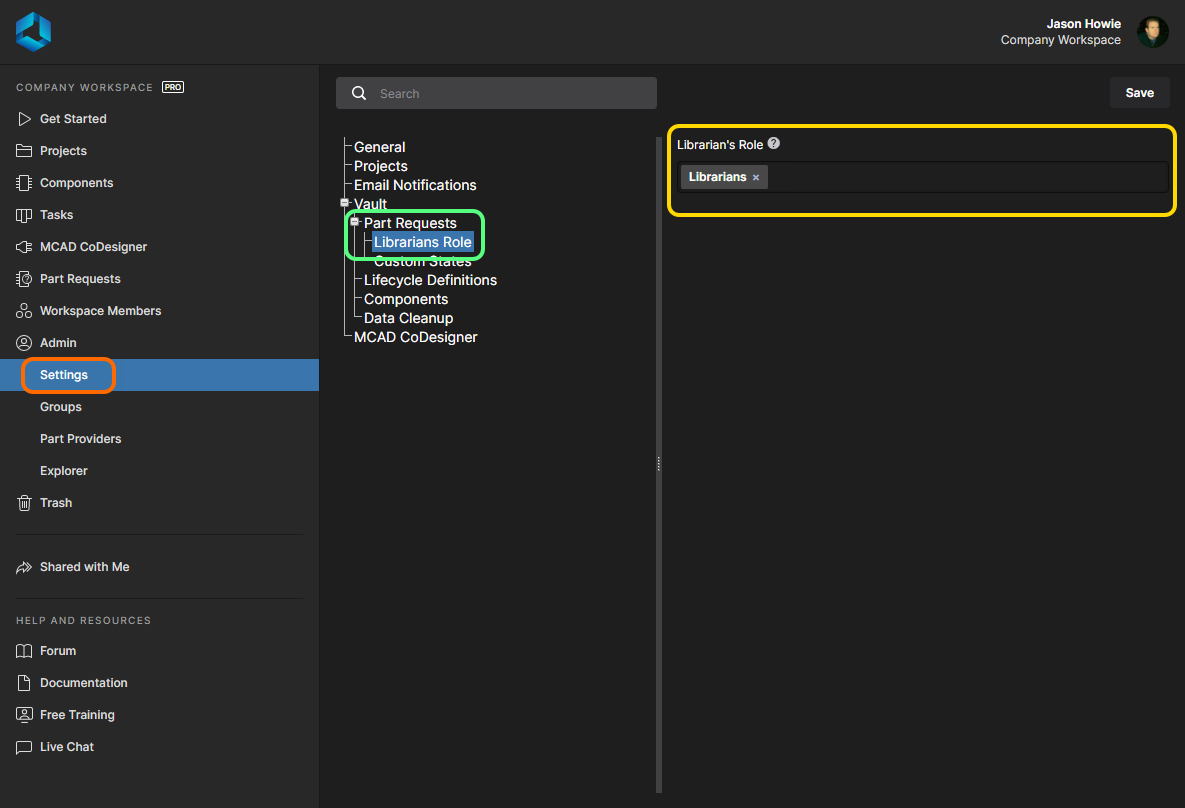 The Librarians Role page of the Admin – Settings area provides the interface for specifying which existing group(s) should be used as Librarians for the Part Request feature.
The Librarians Role page of the Admin – Settings area provides the interface for specifying which existing group(s) should be used as Librarians for the Part Request feature.
As part of the sample data installed when a Workspace is initially created, the sample group Librarians will already be prefilled into the Librarian's Role field – remove if required. Start typing the name of an existing group into the field to pop-up a list of matching groups. Select the required group from this list.
Typically a single existing group would be specified for use as the Librarians role, but multiple groups can be chosen for assignment, especially if your company's librarians are gathered into more than one group. With the required group(s) assigned, be sure to click the ![]() button at the top-right of the page.
button at the top-right of the page.
The members of the nominated group(s) will be the set of Librarians that can be assigned to, and work on, part requests.
 The members of the group assigned to the Librarians role will be the librarians who can handle part requests.
The members of the group assigned to the Librarians role will be the librarians who can handle part requests.
Creating Part Requests
Part Requests can be created and maintained through the Part Requests page of the Workspace's browser interface.
Adding a New Request
To add a new part request, click the ![]() button at the top-right of the page. The page will change to present the new part request form, as shown in the following image and detailed thereafter.
button at the top-right of the page. The page will change to present the new part request form, as shown in the following image and detailed thereafter.
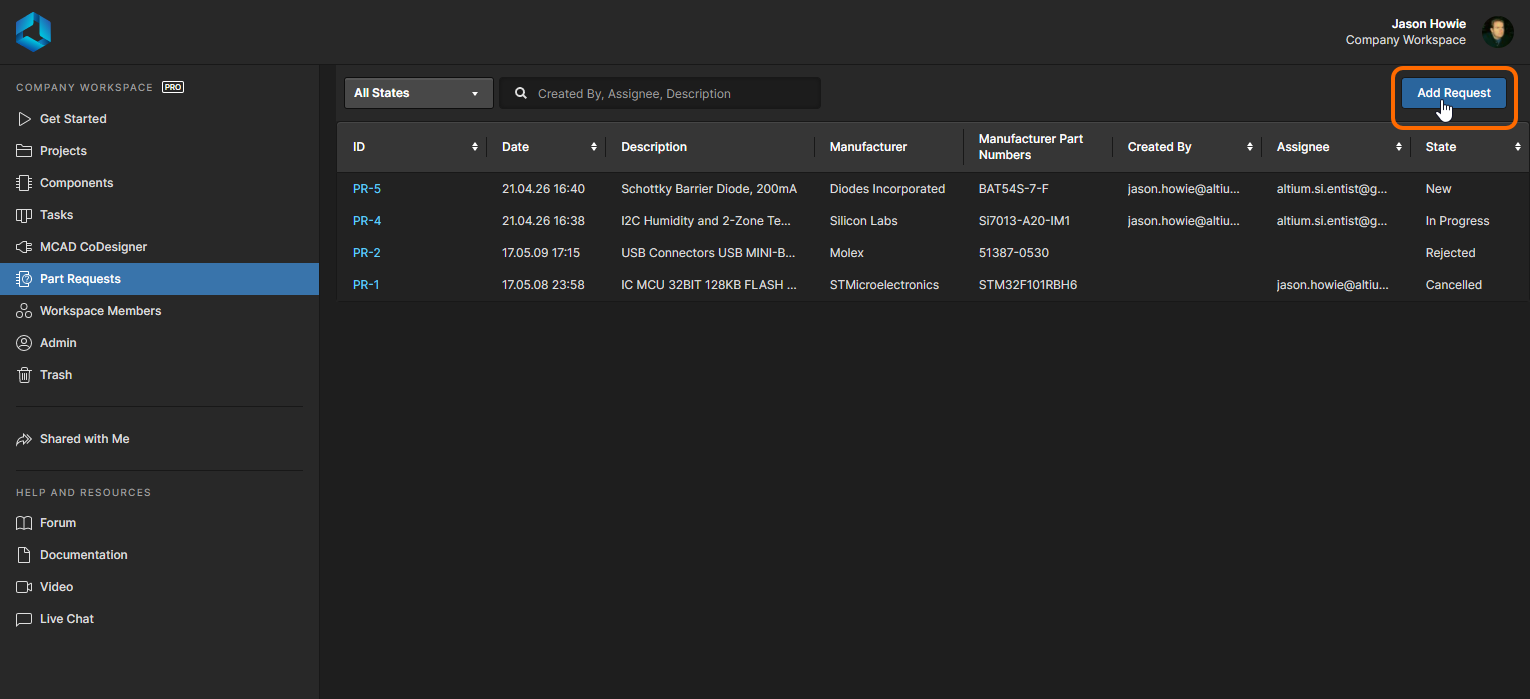 Adding a new part request through the Workspace's browser interface. Hover over the image to see the form presented to receive the details of the request.
Adding a new part request through the Workspace's browser interface. Hover over the image to see the form presented to receive the details of the request.
Use the controls on the page to supply as much information as possible:
- Manufacturer – this is a mandatory field to indicate to the librarian who actually makes the part.
- Manufacturer Part Numbers – this is a mandatory field indicating to the librarian the specific part number(s) of the parts you need them to make. Multiple part numbers must be separated by a comma (,).
- Request Id – an ID is automatically generated with, and assigned to the request, enabling users to easily track the request's progress.
- State – this field is used to specify the status of the request. The options are
Opened: New,Opened: In Progress,Closed: Completed,Closed: Rejected, orClosed: Cancelled.
- Required By Date – use this field to specify the date by which you need the component(s) to be ready. Clicking within the field will pop-up a calendar window with which to specify the required date.
- Assign to – this field shows which librarian is currently working on the request. The drop-down field lists all Workspace users who are part of the nominated Librarian's group(s).
- Component Type – this field can be used to specify the type of component being requested. The drop-down list will include all types currently defined on the Data Management – Component Types page of the Preferences dialog.
- Parameters – this area can be used to add a set of specific parameters required for the part(s). Click Add and use the subsequent fields to provide a name and value for the parameter. If no parameters are specified, the librarian will likely fall back to the addition of the parameters in a related datasheet for that part, in accordance with organizational policy.
- Description – this field can be used to give a rich description of the part (typically taken from the manufacturer datasheet).
- Attachments – this area can be used to attach any useful files related to the requested part, for example a PDF datasheet, an image, or a document. Either click the
 button to locate the file(s) through a standard dialog, or drag and drop the file(s) onto the indicated area.
button to locate the file(s) through a standard dialog, or drag and drop the file(s) onto the indicated area.
- Parts List – use this area to specify any existing Component Item(s) in the Workspace, which you have created as temporary stub components. Click Add and browse for the required Item accordingly. The librarian can then run with this to fulfill the request. If no stub part exists, the librarian will simply create a new Component Item in the Workspace, along with requisite domain model Items.
Once all information is defined as required – and essentially the Manufacturer and Manufacturer Part Numbers (which are mandatory) – click the ![]() button at the top-right of the form, to effect the creation of the request.
button at the top-right of the form, to effect the creation of the request.
With the request saved, its full details will be presented.
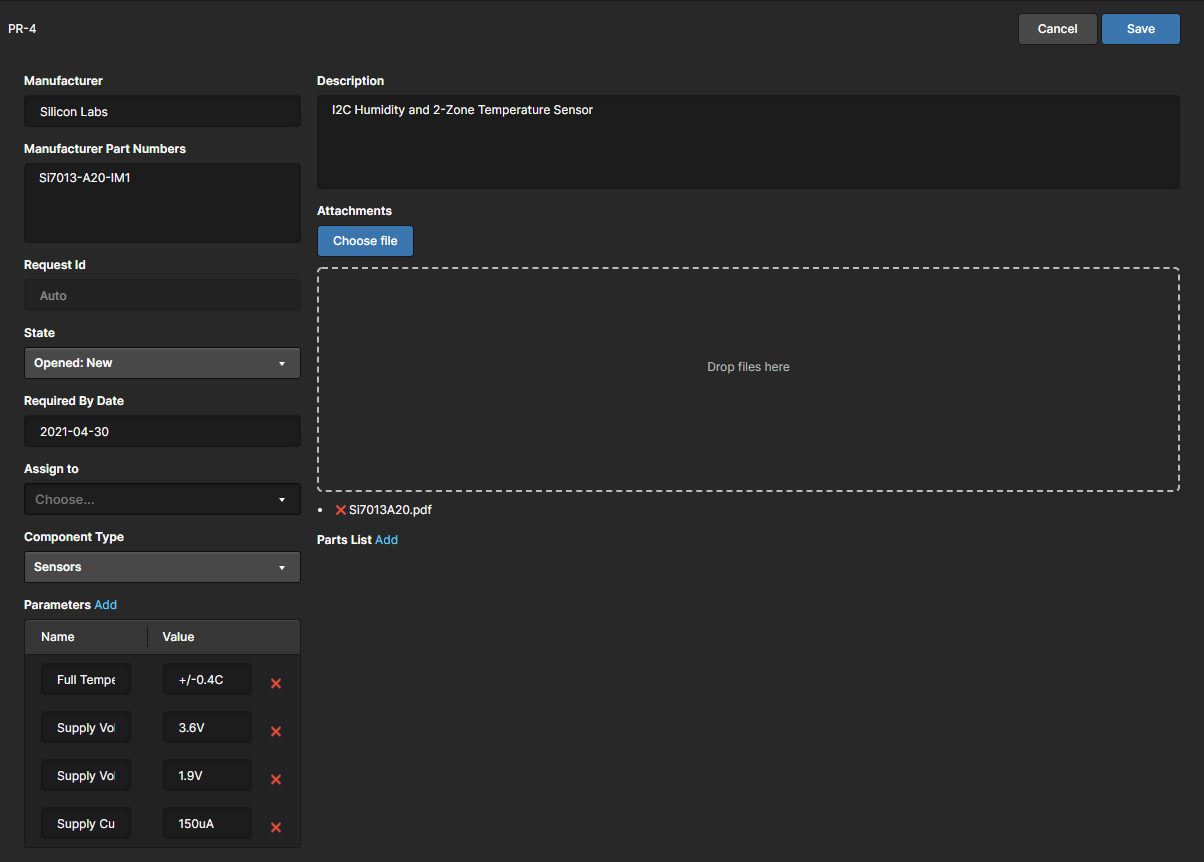 Example of information supplied as part of a new part request. Hover over the image to see the result of saving – full details for the example newly-added part request.
Example of information supplied as part of a new part request. Hover over the image to see the result of saving – full details for the example newly-added part request.
Notice that in addition to the information supplied previously, the following is displayed:
- Request Id – the system-assigned title for the request, in the format PR-n (where n is the next integer identifier available).
- Comment – use this field to comment on the request. This allows for bi-directional communication between the requestor and the librarian. For example, the requestor may change something since the original submission and needs to flag the librarian working on the part. Or perhaps the librarian requires additional information, or confirmation on some aspect of the part. With the comment written, click the
 button to submit it. Any comment will appear in the History region of the page and also in the information stream when viewing the part request in Altium Designer through the Explorer panel.
button to submit it. Any comment will appear in the History region of the page and also in the information stream when viewing the part request in Altium Designer through the Explorer panel. - History – a running stream of events related to this request.
Viewing Part Requests
At any time, a user can view the part requests that they were responsible for initiating (Requestor), or are responsible for working on (Librarian). This can be performed from the Part Requests page of the Workspace's browser interface.
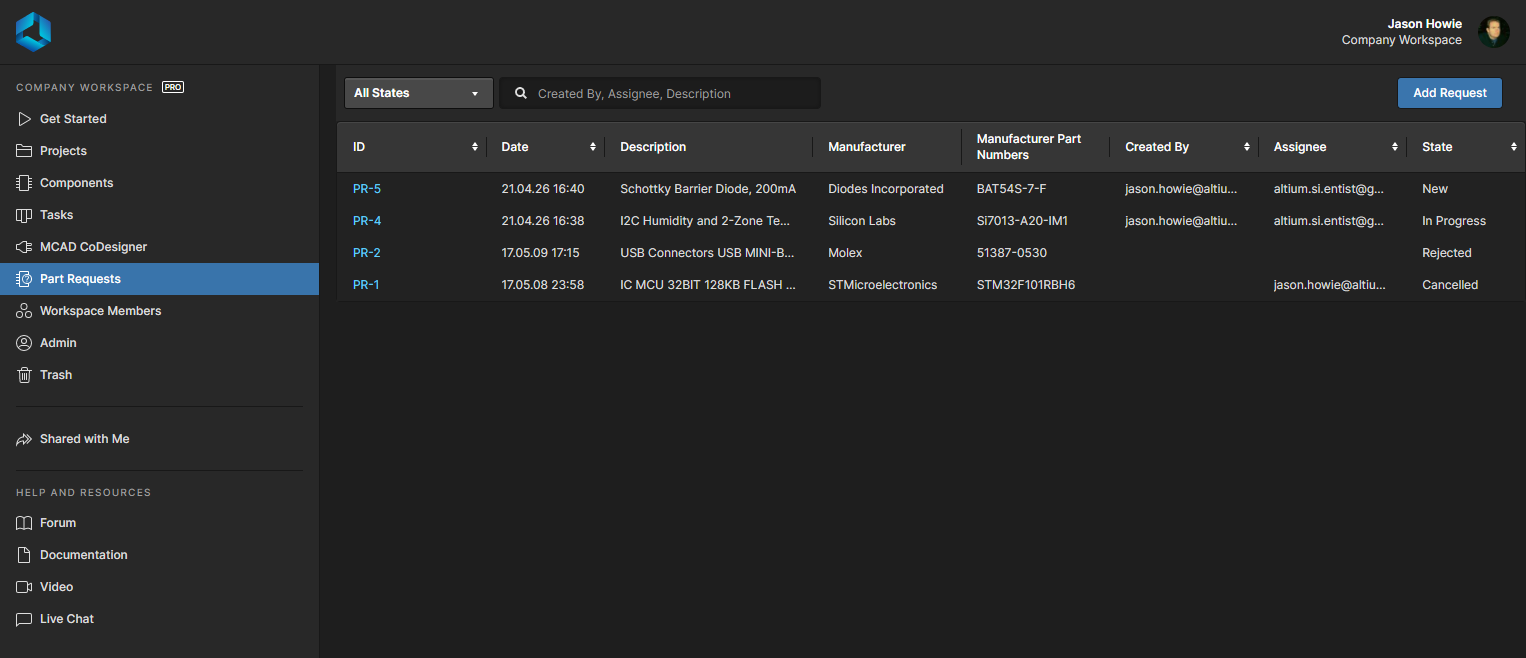 Main summary listing of Part Requests – access this at any time by clicking on the Part Requests entry in the navigation tree.
Main summary listing of Part Requests – access this at any time by clicking on the Part Requests entry in the navigation tree.
Each part request at this summary level is listed in terms of the following supplied information:
- ID.
- Date – the date the request was created.
- Description.
- Manufacturer.
- Manufacturer Part Numbers.
- Created by – the original author of the request (the Requestor).
- Assignee – the Librarian who is currently working on the part request.
- State – the state in which the request currently sits.
You can access the detailed page for a part request by clicking on its ID.
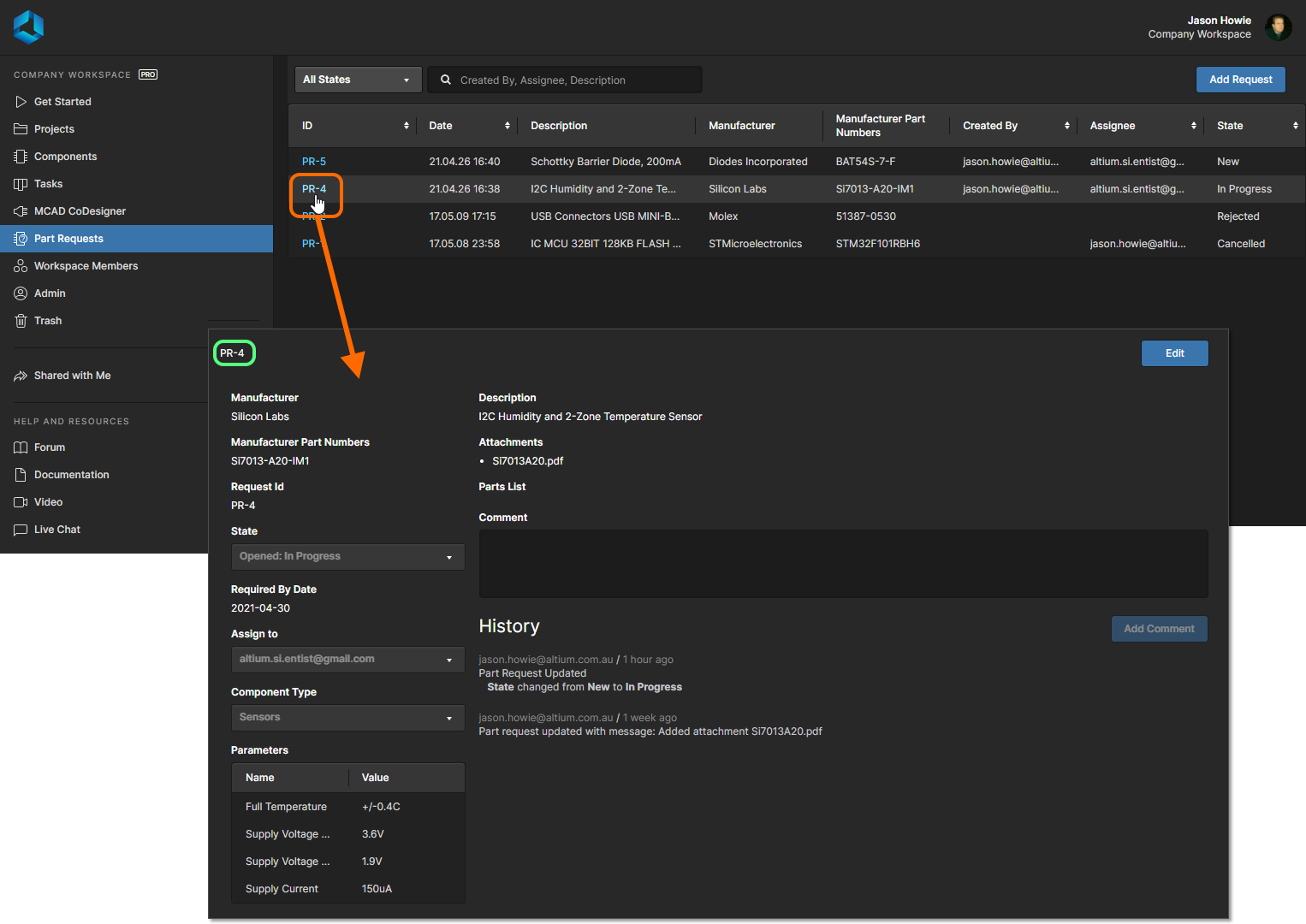 Accessing the detailed page for a part request from the main Part Requests page.
Accessing the detailed page for a part request from the main Part Requests page.
Editing a Part Request
To edit a part request, access its detailed page then click the ![]() button at the top-right of the page. Notice also that a Comment field is available. This is specifically for adding some explanatory text in relation to any modification to the request. This is separate to the Commenting feature available outside of editing the request.
button at the top-right of the page. Notice also that a Comment field is available. This is specifically for adding some explanatory text in relation to any modification to the request. This is separate to the Commenting feature available outside of editing the request.
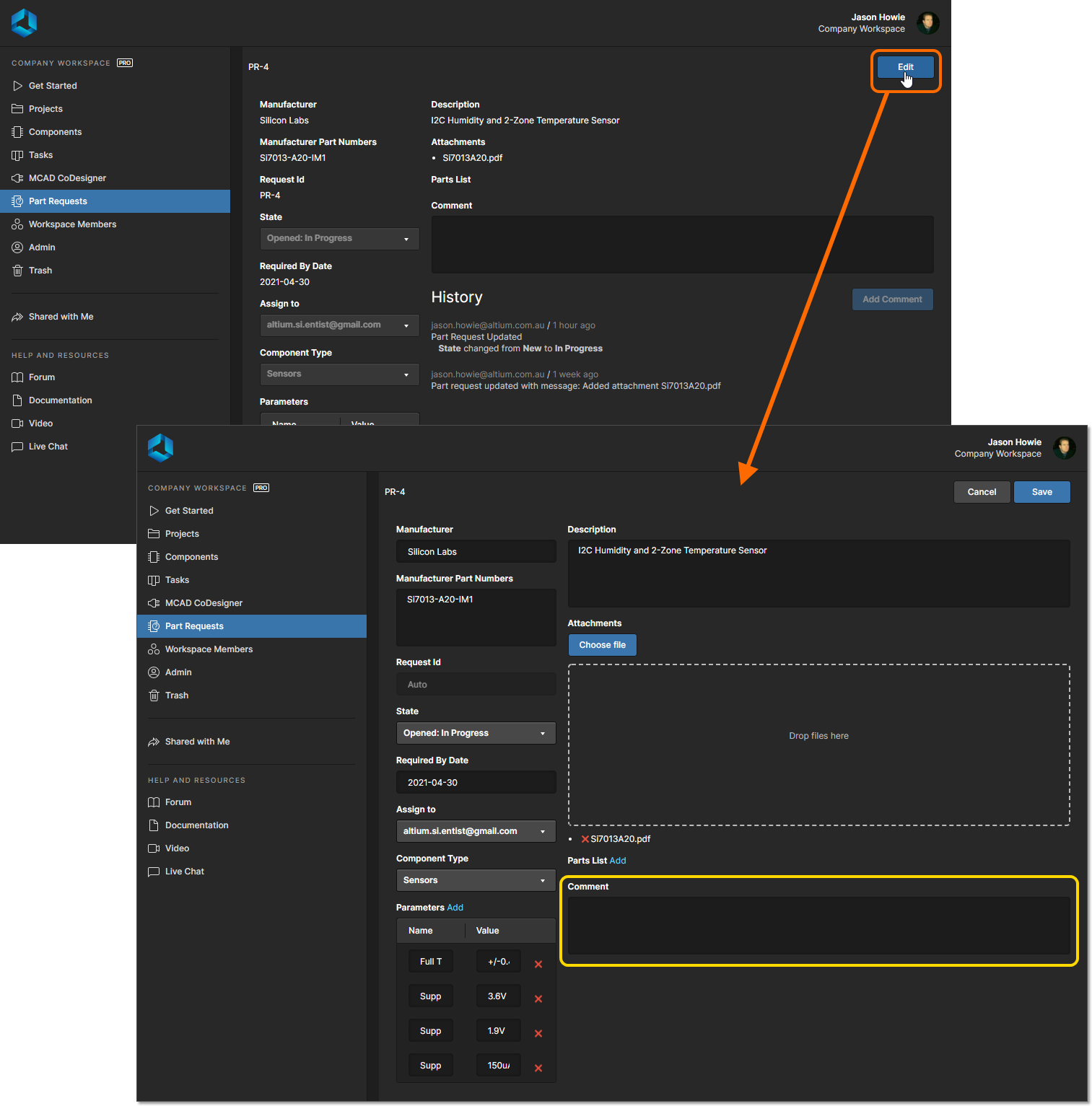 Accessing the form with which to edit an existing part request.
Accessing the form with which to edit an existing part request.
Make changes as required, then click ![]() . To back out without making changes, click
. To back out without making changes, click ![]() .
.
Notifications
Upon creation of a part request the requestor, members of the Librarian group, and Workspace Administrators will receive email notifications – providing the Email Notifications feature is enabled. This is performed by an Administrator, on the Admin – Settings – Email Notifications page of the Workspace's browser interface.
Customizing States
Once the request for a new part has been submitted, there are a number of states that it can ultimately enter. By default, the following states are provided:
- Opened States – states in which the request is currently still 'alive':
- New
- In Progress
- Closed States – states in which the request has been considered resolved and therefore 'closed':
- Completed
- Rejected
- Cancelled
To accommodate the requirements of different organizations, states are customizable. You can:
- Edit the names of the default states.
- Add additional states (named as required).
- Change the ordering of states (how states will appear on the relevant State drop-down menu when creating/editing a part request).
This is configured by an Administrator on the Admin – Settings – Vault – Part Requests – Custom States page of the Workspace's browser interface.
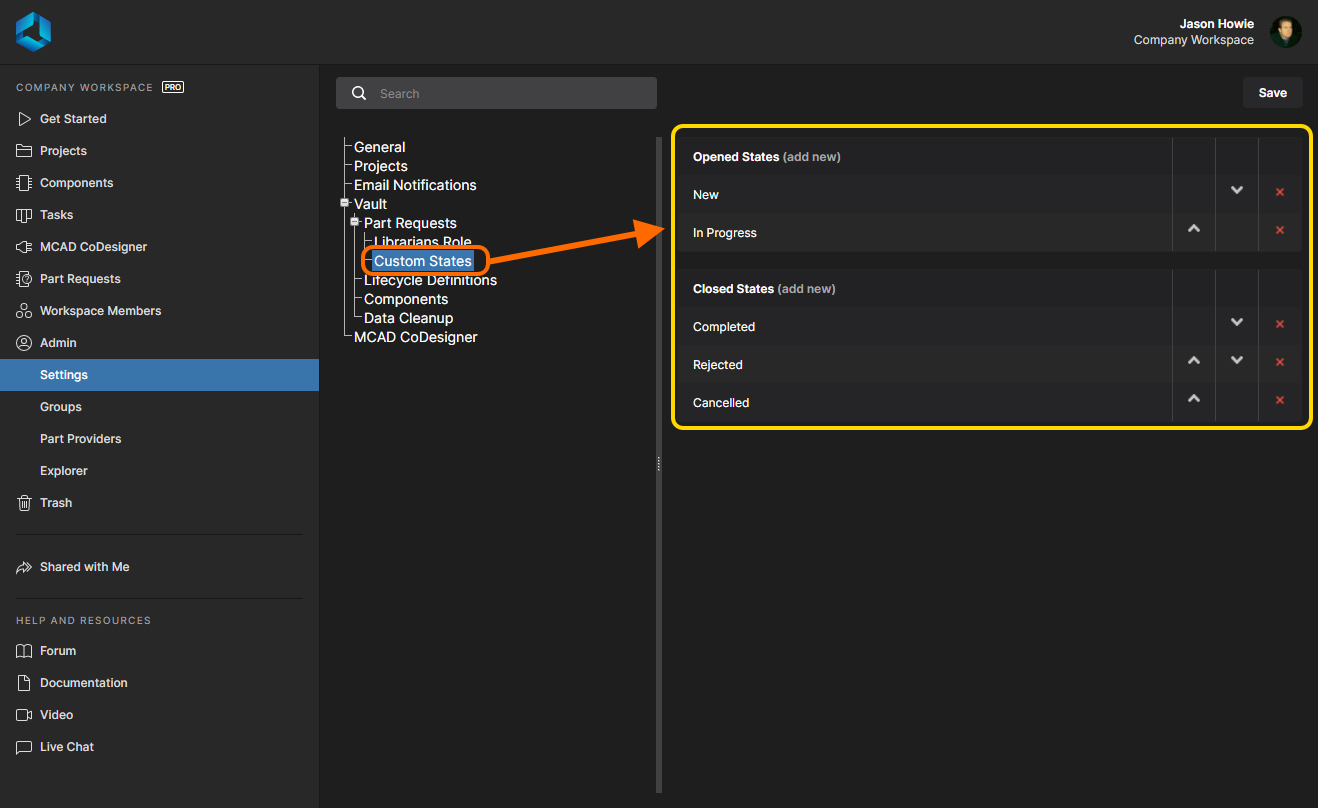 The Custom States page of the Admin – Settings area provides the interface for customizing the states used in the Part Request feature.
The Custom States page of the Admin – Settings area provides the interface for customizing the states used in the Part Request feature.
Make changes as follows:
- To edit the name of an existing state, click on its name. The Custom State Name window will appear in which to do so.
- To add a new state, click the add new control, associated with the type of state (opened or closed). Use the Custom State Name window to give the state the required naming.
- To change the order of the states, use the Move Up (
 ) and Move Down (
) and Move Down ( ) controls, as applicable (and where available).
) controls, as applicable (and where available). - To remove a state, click its associated Remove control (
 ).
).